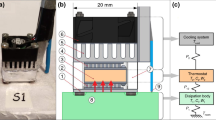Abstract
Pressure ulcers of the buttocks in persons confined to wheel-chairs can be a serious problem. The reduction in blood flow to the tissues caused by the pressure from the ischial tuberosities is a key factor in pressure ulcer development of the buttocks. Also, increase in tissue temperature due to surface insulation, or systemic temperature increase, are risk factors in pressure ulcer development. The aim of this study was to investigate the effect on skin temperature of pressure alone, regardless of surface insulation. Able-bodied, healthy individuals (n = 12) were subjected to an increase in pressure of the tissues overlaying the left ischial tuberosity up to 320 mmHg. The skin temperature was measured on the loaded left buttock half and on the unloaded right buttock half for control. The skin temperature increased significantly 2.7 (0.4)°C (men) and 2.7 (0.6)°C (women) on the loaded left side (p < 0.001 for both groups). When pressure was relieved, a period of hyperemia followed, this increased the temperature further significantly (2.0 (1.0)°C (men, p < 0.01) and 1.3 (0.6)°C (women, p < 0.05)). During hyperemia, maximum temperature was reached after 366 (257) s (women) and 266 (88) s (men). In conclusion, the increase in temperature is most likely to be caused by facilitated heat conduction from the body core caused by compression of the tissues. An increase in temperature as a result of loading may make the tissues even more vulnerable to pressure-induced ischemia due to an increase in metabolic demand.



Similar content being viewed by others
References
Ferrell BA, Josephson K, Norvid P, Alcorn H (2000) Pressure ulcers among patients admitted to home care. J Am Geriatr Soc 9:1042–1047
Fuhrer MJ, Garber SL, Rintala DH, Clearman R, Hart KA (1993) Pressure ulcers in community-resident persons with spinal cord injury: prevalence and risk factors. Arch Phys Med Rehabil 11:1172–1177
Makhsous M, Priebe M, Bankard J, Rowles D, Zeigler M, Chen D et al (2007) Measuring tissue perfusion during pressure relief maneuvers: insights into preventing pressure ulcers. J Spinal Cord Med 5:497–507
Smith BM, Guihan M, LaVela SL, Garber SL (2008) Factors predicting pressure ulcers in veterans with spinal cord injuries. Am J Phys Med Rehabil 9:750–757
Allman RM (1997) Pressure ulcer prevalence, incidence, risk factors, and impact. Clin Geriatr Med 3:421–436
Lindgren M, Unosson M, Krantz AM, Ek AC (2002) A risk assessment scale for the prediction of pressure sore development: reliability and validity. J Adv Nurs 2:190–199
Sae-Sia W, Wipke-Tevis DD, Williams DA (2005) Elevated sacral skin temperature (T(s)): a risk factor for pressure ulcer development in hospitalized neurologically impaired Thai patients. Appl Nurs Res 1:29–35
Stewart SF, Palmieri V, Cochran GV (1980) Wheelchair cushion effect on skin temperature, heat flux, and relative humidity. Arch Phys Med Rehabil 5:229–233
Analyse-it for Microsoft Excel. 2.12 ed. Leeds: Analyse-it Software, Ltd. 2008
Johnson RL, Gerhart KA, McCray J, Menconi JC, Whiteneck GG (1998) Secondary conditions following spinal cord injury in a population-based sample. Spinal Cord 1:45–50
Kroger K, Niebel W, Maier I, Stausberg J, Gerber V, Schwarzkopf A (2008) Prevalence of pressure ulcers in hospitalized patients in Germany in 2005: data from the Federal Statistical Office. Gerontology
Thorfinn J, Sjoberg F, Lidman D (2002) Sitting pressure and perfusion of buttock skin in paraplegic and tetraplegic patients, and in healthy subjects: a comparative study. Scand J Plast Reconstr Surg Hand Surg 5:279–283
Thorfinn J, Sjoberg F, Lidman D (2007) Perfusion of buttock skin in healthy volunteers after long and short repetitive loading evaluated by laser Doppler perfusion imager. Scand J Plast Reconstr Surg Hand Surg 6:297–302
Thorfinn J, Sjoberg F, Sjostrand L, Lidman D (2006) Perfusion of the skin of the buttocks in paraplegic and tetraplegic patients, and in healthy subjects after a short and long load. Scand J Plast Reconstr Surg Hand Surg 3:153–160
Thorfinn J, Sjoberg F, Lidman D (2009) Sitting can cause ischaemia in the subcutaneous tissue of the buttocks, which implicates multilayer tissue damage in the development of pressure ulcers. Scand J Plast Reconstr Surg Hand Surg 2:82–89
Acknowledgments
This study has been supported by the Swedish Fulbright Commission, the County Council of Östergötland (Sweden), the Medical Research Council of Southeast Sweden, Börje Gabrielsson’s Memorial Fund, the Swedish Society of Medicine, the Johan & Jakob Söderberg Foundation, and the Linköping Society of Medicine.
Author information
Authors and Affiliations
Corresponding author
Rights and permissions
About this article
Cite this article
Angelidis, I.K., Lidman, D., Sjöberg, F. et al. Decubitus ulcer development: pressure alone increases tissue temperature. Eur J Plast Surg 32, 241–244 (2009). https://doi.org/10.1007/s00238-009-0351-6
Received:
Accepted:
Published:
Issue Date:
DOI: https://doi.org/10.1007/s00238-009-0351-6




